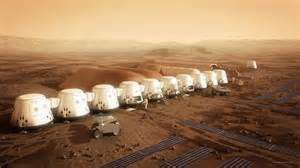As I discussed in my two previous posts, NASA has laid out a three-stage plan for developing the technology and systems necessary to carry us to Mars, humanity’s first step toward becoming a space-faring species.
Stage 3 is called Earth Independent. In this final phase, activities will build on what we learn on the International Space Station (ISS) and in cislunar (near-moon) space to enable human missions to the Mars vicinity, including the Martian moons, and eventually the Martian surface. With humans on Mars, we will be able to advance science and technology in ways only dreamed of with current robotic explorers.

Future Mars missions will represent a collaborative effort among NASA and its partners—a global achievement that will mark a transition in humanity’s expansion as we go to Mars not just to visit, but to stay. Goals include:
- Living and working within transit and surface habitats that support human life for years, with only routine maintenance
- Harvesting Martian resources to create fuel, water, oxygen, and building materials
- Leveraging advanced communication systems to relay data and results from science and exploration excursions with a 20-minute delay
Food to fire the imagination of all science fiction writers.
